Sign-up now and become
a Franchisee at Snap‑on
Snap-on rewards people who make a positive difference.
In 1920, a cultural shift was underway in the United States as the automobile was rising in popularity, creating the need for an emerging automotive repair industry. Joseph Johnson, an engineer from Milwaukee, had an idea that would revolutionise repair and make work easier for professional mechanics.
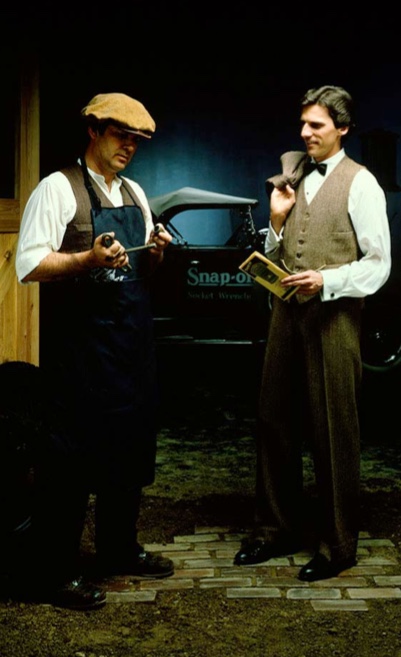
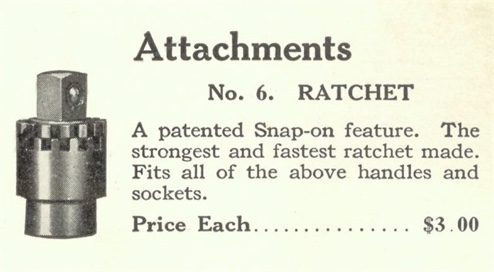
In 1923, Snap-on filed for its first patent, a ratcheting attachment. The No. 6 Ratchet was designed by Joseph Johnson and was the first ratcheting attachment made for use with the original set of interchangeable socket wrenches.
First Product Catalog
Throughout the 1920s, the Snap-on product line continued to grow. In 1923, Snap-on published its first product catalog.
Establishing Branches Nationwide
With initial success in the Chicago-Milwaukee corridor, the founders decided to expand geographically. In December 1920, Stanton Palmer and Newton Tarble identified 20 cities where branch offices would be established. By 1925, there were 17 branches and 165 salesmen selling Snap-on hand tools direct to mechanics.
New Home in Kenosha
As Snap-on continued to prosper, the growth strained its rented Milwaukee facility. In 1929, an eleven-acre site was purchased on the outer edge of Kenosha to consolidate manufacturing and its general offices, then located in Chicago. The Kenosha Chamber of Commerce and the Greater Kenosha Land Company recruited Snap-on to diversify the economy.
Custom Kits Meet Customer Needs
With car models expanding, Snap-on saw an opportunity to produce customized tool sets for each model. The Model T kit contained a diagram indicating where each tool was to be used. Snap-on was praised for this timesaving innovation in a December 1924 article in Ford Owners and Dealer publication.
Reaching Beyond Auto Repair
Early Snap-on salespeople capitalized on industrial sales by offering Heavy Duty, Extra Heavy Duty and Jumbo socket lines to customers repairing trucks, airplanes, farm equipment, and road machinery and for maintenance in mills, mines and power plants.
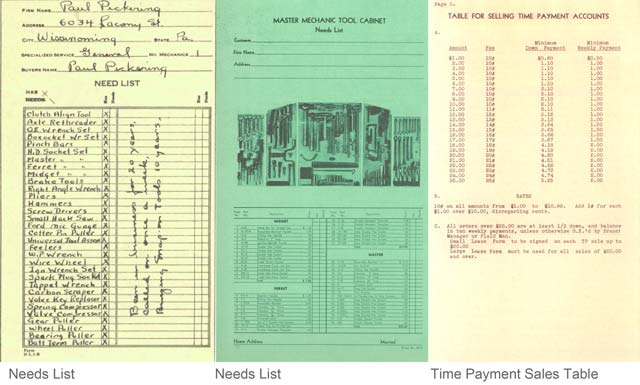
In the grip of the Great Depression, Snap-on salesmen would say to their customers, “Everybody is in a fix today – no money – but when you have money again, what tools will you need?” They called these “Dream Orders.” The novel idea quickly developed into a “Needs List,” and is still used with success today.
Credit Approved
During the Great Depression, struggling mechanics couldn’t afford the tools they needed and no institution at the time would lend them money. Snap-on became the first tool company to do so, offering “Time Payment” selling, or “T.P.” The program allowed mechanics to earn while they paid. At the same time, it enabled salesmen to build long-lasting goodwill. T.P. became a precursor to the Revolving Account payment plan used today.
International Expansion
As word spread of Snap-on, orders began to come in from around the world. In the 1920s, international orders were filled through a New York City export office and through various trade shows. With Canadian demand for Snap-on tools surging, the first branch was opened in Montreal in 1927. Snap-on Tools of Canada Ltd. was incorporated and became the first international subsidiary on July 29, 1931.
The First in a Long Line
Snap-on paid its first dividend to shareholders in 1939, beginning a streak of unreduced quarterly dividends that has continued without interruption to this day.
Precision Torque
In the late 1930s, Snap-on responded to the need of taking the guesswork out of applying torque. Snap-on reached an agreement with Precision Instruments, Inc. to manufacture “Torqometers.” The torqometer is a wrench and gauge combination that ensures accurate and uniform nut tightening, providing proper clamp loads and durability. Snap-on was one of the first companies to offer a complete range of torqometers, which were essential in automotive, aerospace and industry, and enjoyed a patented position in the market for many years.
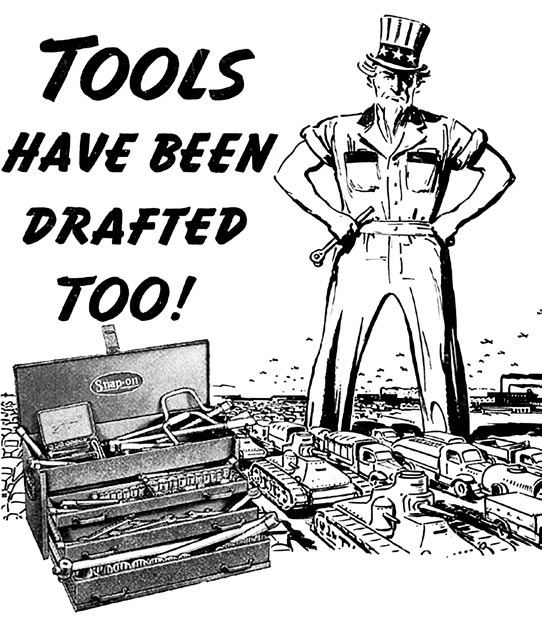
The early 1940s were marked by World War II and the military experienced severe tool shortages as a result. As a preferred supplier to the government, Snap-on was called into action, producing tools that kept air and ground equipment operating. Wartime demands also led to product innovations. To increase durability of hand tools, the military upgraded the Snap-on material specifications and authorized buying nickel alloy steel, which ultimately became a Snap-on standard. To meet specific demands, hand tools for aviation and large sockets and wrenches for heavy military equipment were also developed.
The First Aligners
Following the war, there were 40 million cars on the road. People were driving more and traveling farther distances. Roads were often in poor condition and many were unpaved. Because of this, wheel alignment became a necessity, with roughly six million wheel alignments being performed each year.
Railroad
The evolution of transportation from passenger rail to automobile and growth in moving freight by truck sparked changes in the railroad industry. The launch of the diesel locomotive created efficiencies for railroads and an opportunity for Snap-on. Even though Snap-on tools were used for railroad maintenance since the early years of the Company, demand began to increase. So, in 1944 Snap-on created a railroad department because of the highly specialized nature of their product line. It was likely the only such department in any tool company in the United States—perhaps in the world.
Independent Businessmen
With the primary focus of the Company on supplying tools to the military during World War II, the civilian market was suffering tool shortages. In response to the challenge, Snap-on developed an important new selling system. Any available tools were released, sold or consigned directly to Snap-on salesmen, to maintain customer loyalty. They took these products directly to their customers in the most expedient way possible—in their personal cars, stations wagons or vans. As a result, the concept of the salesman as an independent businessman was born.
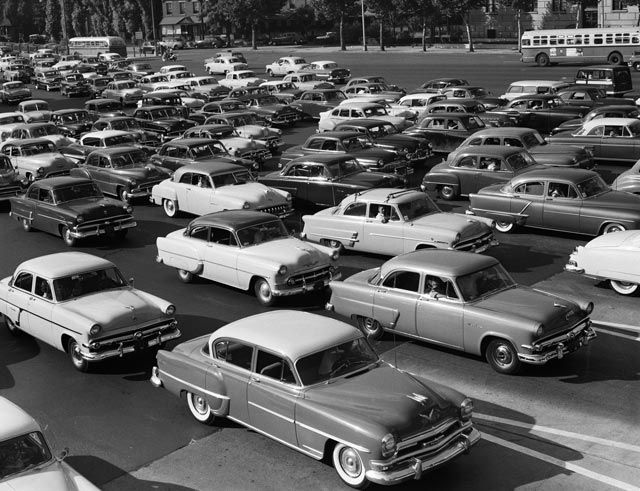
Post-war America began an era of optimism and growth of the middle class. The baby boom created a surge in home construction and a departure from the city to the suburbs. Economic prosperity paved the way for the interstate highway system and demand for new cars. Car ownership in the 1950s grew from 25 million to 70 million registrations and one in six workers were said to have been tied to the auto industry. The car culture created new business segments such as malls, drive-in theatres, fast food restaurants and car related sports, like drag racing, and stock car racing emerged. Snap-on was well positioned to take advantage of this cultural shift; the dealer network continued to expand as a result of the fast developing auto repair industry and industrial sales accelerated as factories returned back to pre-war production.
Aviation & Aerospace
Snap-on has participated in aviation milestones since the 1920s. From the Spirit of St. Louis crossing the Atlantic in 1927, to Richard Byrd’s Antarctic Expedition in 1933, to Howard Hughes’ record breaking around the world flight in 1938, Snap-on delivered confidence to aviation mechanics. During the 1950s, thousands of “tight-access” or “thin-wall” special application tools were made. These innovations were the direct result of Snap-on customer connection early on. Today, “thin-wall” sockets are a standard offering of the Snap-on® socket product line.
Mexico Expansion
The acceleration of industrial progress in Central and South America led to the formation of the subsidiary, Herramientas Snap-on de Mexico, S.A. (HSM), with a branch in Mexico City. The majority of people didn’t own cars, but taxis and buses were abundant in metropolitan areas—and in constant need of repair.
Weidenhoff & Judson
Snap-on’s product portfolio continued to expand in the 1950s with the addition of test equipment and wheel service products. The Weidenhoff Corporation of Algona, IA was acquired in 1956. This brought the manufacture of automotive test equipment into the Snap-on line. Voltmeters, Ammeters, Distributor and Alternator Testers and the Anal-O-Scope, the first oscilloscope for automobiles in the United States, were among the early innovations. The Weidenhoff plant more than doubled its size in 1959 to manufacture tool storage cabinets and housings for meters, previously provided by outside manufacturers. Judson Engineering of Natick, MA was acquired in 1959. This brought new design and manufacturing of wheel alignment equipment, such as caster-camber gauges, as well as wheel balancers, into Snap-on’s portfolio.

At this time, the aviation industry was making advancements in reducing space and weight by modifying fasteners, but was struggling with rounding of the fastener corners upon removal. The Navy sought Snap-on to solve this dilemma. The solution, called the Flank Drive® Wrenching System, was issued two patents in 1965 and proved so popular that it spread throughout the Snap-on product line. Each hex point of the socket was curved to prevent contact with the fasteners’ corners and the angles of the sides were altered to improve flat-to-flat contact.
Product Line Expands
Car models were expanding, advancements, such as air conditioning, were increasing and the interstate road system enabled car owners to drive more. In 1967, 39% of all cars produced were factory equipped with air conditioning, and the trend was increasing. Air conditioning was coming of age and brought with it a brand new and wide open market for the special tools needed for servicing these systems. Dealers were trained to show a diagram of an air conditioning system to illustrate to mechanics the simplicity of repairs with a Snap-on A/C maintenance set and to explain the income opportunity from servicing these systems. The result for Snap-on was reconfiguration of its plants to increase capacity and add product lines.
Growth & Global Expansion
The 1960s were a time of tremendous geographic expansion for Snap-on, with sales growing from $28.3 million in 1960 to $76.5 million in 1970. The van model was initiated in the U.K. in 1965 and was serviced by a new branch and distribution center set up in Kettering, Northamptonshire.
Unified Marketing & Distribution Approach
By this decade, the network of U.S. branches had grown from 17 in 1925 to 42 in 1960. Originally a distribution system of independent branches, Snap-on’s purchase of the St. Louis branch completed a strategic acquisition of all 42 branches, giving a singular approach to marketing and distribution.
Education Programs
In 1928, over 300 auto mechanic instructors from all over the United States attended a training session at the Stout Institute in Menomonie, Wisconsin to learn about the Snap-on product line. Building on the early success of these training sessions, Snap-on launched its first formal education program in 1965. The Educational Service Program (ESP) was designed to assist technical education instructors in the training and development of student mechanics.
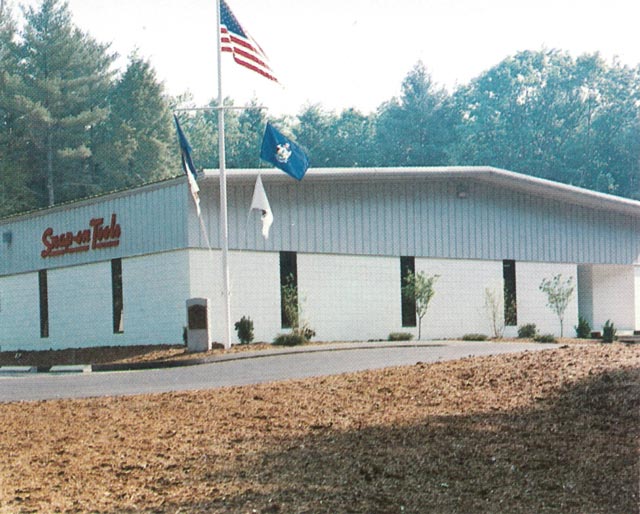
As Snap-on celebrated its 50th anniversary in 1970, it began a decade of explosive growth. The number and variety of products jumped 30% and capacity was added through plant expansions. A new facility in Bensenville, IL was dedicated to the research and development of new manufacturing processes, and two new distribution centers were opened in Robesonia, PA and Carson City, NV to keep products moving efficiently. For the decade, Snap-on net sales grew from $76.5 million in 1970 to $373.6 million in 1979.
The “Big Board”
As Snap-on prospered and gained further prominence as a public company, a stock listing on the “Big Board” was appropriate. As such, Snap-on’s common stock began trading on the New York Stock Exchange under the ticker symbol “SNA” on February 27, 1978. Previously, the stock was bought and sold over-the-counter.
From Machining and Broaching to Cold Forming
In the late 1970s, Snap-on launched a patented manufacturing breakthrough called “cold forming.” Developed by Snap-on engineers and first used to produce sockets, the cold forming process extrudes tools from high quality, proprietary alloy steel, which flows around the punch, taking the object’s shape. As opposed to the previous method of machining and broaching sockets, the benefits of cold forming are many, such as production capacity increased over tenfold, sockets were stronger and more impact resistant—improving tool life by up to 20 times the baseline, and scrap was decreased by 67%.
Connecting with Industrial Customers
As industrial markets became more complex, detailed knowledge of key applications was critical for both new tool development and sales. For example, the trend towards metric fasteners in both the automobile and aviation industries prompted the addition of a large number of new metric wrenching tools. Field training sessions were established to understand applications and tool usage for specific markets. These workshops enabled the salesmen to connect at a deeper level with customers and develop customized, industry specific tools designed by the “specials group.”
A Cut Above the Rest
As the Snap-on product line expanded, so did the need for tool storage solutions. Mechanics could choose from a broad range of roll cabinets, tool chests, drawer sections and end cabinets to fit their specific needs. Snap-on set the standard with features like heavy gauge steel, reinforced lids, all welded construction and a high quality paint finish. Snap-on® tool storage was the choice of mechanics because in addition to uncompromising quality and durability it created a sense of pride and displayed a high level of professionalism.

In the late 1980s, the “Soaring to New Heights in Customer Service” theme was created as the Corporation strived to reach the $1 billion sales milestone. The eagle, a powerful, regal bird known for fast and furious flight, was chosen as the symbol to guide the Company to even higher levels of quality and customer service. In 1987, the $1 billion sales goal was achieved.
NASA
From servicing the Lunar Roving Vehicle or “Moon Buggy” to the Space Shuttle and Space Station programs, Snap-on tools were there. In 1983, Snap-on developed torqometer adaptors that fit stainless steel fasteners with a ¼” clearance. An L-shaped combination wrench, developed by Snap-on engineers, was used for refueling an astronaut’s backpack and fastening it into the cargo bay of the space shuttle. To accommodate the rough conditions and extreme temperatures, the ratchet was coated with nickel plating, had a large spinner head with a notch in the perimeter, a fiberglass handle for easier gripping while wearing space gloves and was tethered. Sometimes working with as little as a few days to invent solutions, NASA relied on Snap-on to deliver.
Motorsports
Snap-on’s rich history in motorsports grew from customers’ affinity for racing and serves as further proof that Snap-on performs under the harshest of conditions. Whether on the track or in the pits, a few seconds can mean the difference between winning and losing. Snap-on tools are used by top motorsports teams because under these conditions, failure is not an option. Snap-on tools were used by race teams as early as the 1920s and that tradition continued when Snap-on became affiliated with Rick Mears in 1982, largely considered the most successful driver of the 1980s. The four-time Indianapolis 500 winner was a customer favorite and appeared at Snap-on functions and participated in several advertising campaigns. The initial affiliation with open wheel racing soon expanded to Stock Car Racing (NASCAR) and Drag Racing (NHRA).
Expanding the Aviation Tool Offering
In 1986, Snap-on acquired ATI Industries in Escondido, CA to serve the aerospace industry with precision aircraft specialty tools and missile components. Major customers at the time included Boeing, Grumman, General Dynamics, McDonnell Douglas and the U.S. Air Force and Navy. Today ATI is located in City of Industry, CA sharing its location with Snap-on Specialty Tools.
End of an Era
Joseph Johnson, whose brilliant idea changed repair service forever, died on October 15, 1986 at the age of 92. Johnson left an indelible mark, not only as an inventor and Snap-on founder, but also as a business leader and community servant. In 1939, Johnson became president of Snap-on, serving until his retirement in April 1959. He continued to serve on the board of directors until 1975.
Snap-on Down Under
Direct selling in Australia took shape in 1982 when the first Snap-on Dealer began operations in Sydney. As demand grew, Snap-on opened the first Australian branch in 1988 located in Brisbane, a large trade hub on the East coast. Sales volume was just under 1 million AUD in that first year. In 1989, operations were expanded, and sales tripled the following year.
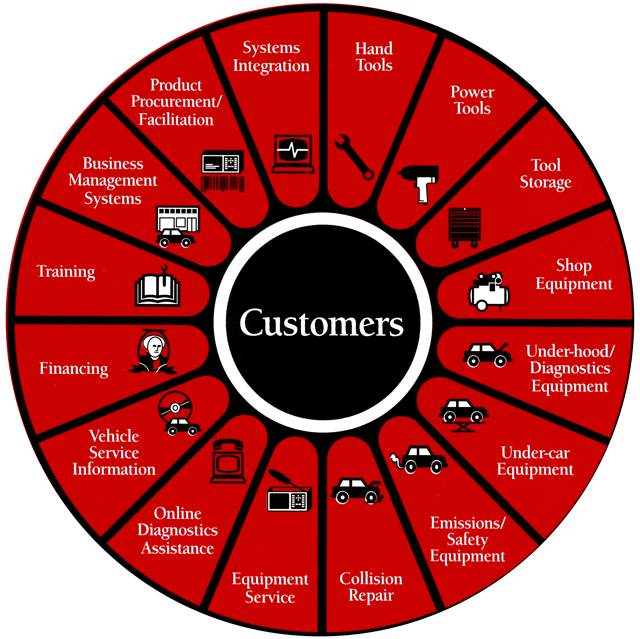
Throughout the 1990s, Snap-on continued to expand product lines globally to better serve professionals in critical industries. To deliver a more comprehensive total shop solution for repair shop owners and managers, well known brands such as Sun®, Mitchell1®, John Bean® and Hofmann® expanded the product portfolio in diagnostics, repair information, alignment and undercar equipment. The Sioux® and Williams® brands were acquired to extend our offering in power tools and hand tools for critical industry segments such as aviation and oil and gas. To expand our tool offering for professional tradesmen internationally, Snap-on purchased Eurotools in 1995, which included established European brands such as Irimo®, Irazola®, Palmera® and Acesa®. In 1999, Sandvik Saws and Tools, a division of Swedish based Sandvik AB, became a part of the Snap-on family, not only adding a full range of saws and accessories, but also a global manufacturing base. With this, Snap-on acquired the Bahco® brand with its iconic fish and hook logo. This design is one of the world’s oldest trademarks still in use, registered on January 28, 1879, and remains a key element for the Bahco® brand identification. In total, more than two dozen companies were acquired during the decade, increasing Snap-on’s capabilities to reach more customers.
Engineering Evolution
Mathematical modeling, worker comfort, colors, regulations and vehicle complexity played a role in product development in the 1990s. Snap-on engineers invented the Flank Drive Plus wrenching system in 1990, which provided the user with 40% more turning power, thanks to modeling tools, like finite element analysis. To improve worker comfort, soft-grip screwdrivers and ergonomically designed pliers were launched. A patented sealed ratchet design increased tool life by keeping dirt out, requiring less maintenance. After 70 years of Kenosha Red (KR) toolboxes, Snap-on debuted new, colorful finishes. Power tools gained prominence with the launch of a 3⁄4” impact wrench and cordless power tools. The Counselor II oscilloscope performed a wide variety of tests and the MT2500, or “Red Brick,” was the first handheld diagnostic tool to enable mechanics to efficiently diagnose trouble codes.
Becoming a Franchise Network
In 1990, Snap-on became the first mobile tool company in the U.S. to convert to a franchise operation. Standardized product and business operations, training and support, a focused marketing plan and the National Dealer Advisory Council, later renamed the National Franchise Advisory Council (NFAC), were introduced to increase support for franchisees and to foster a strong relationship between Snap-on and its franchisees. In 1994, Entrepreneur Magazine ranked Snap-on as the “top new franchise.”
Technical Training
In the 1990s, Snap-on continued to expand its education programs. The Snap-on Technical Training program was operating across the U.S., offering 50 courses on applications such as automotive technology, equipment, A/C certification and many others. After completing a course, auto mechanics were granted certificates and achievement stamps, which they could proudly display in their garage or dealership. The certificates further signify them as a professional, and customers who saw these Snap-on certificates would know that their mechanic could do the job right.
Snap-on Japan
Although products were sold in Japan as early as the 1920s, it wasn’t until 1989 that a subsidiary, Snap-on Tools Industrial Japan (SIJ), was formed, beginning modestly with only three employees and serving primarily industrial customers. In January 1992, the name was changed to Snap-on Tools Japan, K.K. (SOJ) and an aggressive franchisee recruiting program was launched. By the fall of 1992, SOJ had 133 Franchised Vans and sales of $12 million.
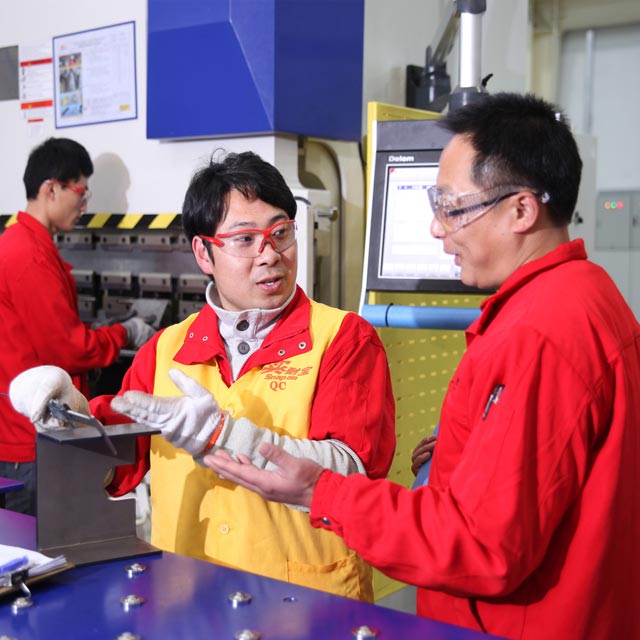
RCI is a structured set of tools and processes, used by associates globally to eliminate wasted effort and create productivity and quality, leading to sustainable operating efficiencies. Beginning in 2005, Snap-on enlisted the masters of the Toyota Production System, Shingijutsu, as a guide. The teachings of Shingijutsu combined with RCI leaders in locations around the world provide the expertise and passion to create a culture of rapid continuous improvement. The highlight of the year is the opportunity to share best practices at the RCI Showcase at the Annual Global Leadership Conference.
Runways For Improvement
The Snap-on Value Creation Model is the suite of business practices that work to attain operating improvements; a collection of powerful disciplines employed every day to drive safety, quality, customer connection, innovation and rapid continuous improvement (RCI).
Expanding with OEM and Heavy Duty
In 2002, Snap-on acquired Nexiq Technologies, a leader in diagnostic scan tools for heavy duty trucks. From fleet maintenance operations to independent repair shops, products such as the PRO-LINK iQ™ offer heavy-duty coverage for many commercial vehicles in one tool. In 2006, Snap-on extended its capability to repair shop customers by acquiring ProQuest Business Solutions, a leader in the development and distribution of electronic parts catalogs for Original Equipment Manufacturer (OEM) customers.
Tool Certification
In 2007, Snap-on partnered with educational institutions to begin offering curriculum-based product certifications to students. Curriculum and testing for these certifications, developed and administered by the National Coalition for Certification Centers (NC3), benefit industry by providing relevant skills needed in today’s workplace and by giving students stackable credentials, thus increasing career opportunities.
Credit: A Unique Advantage
Extending credit has been an essential component of Snap-on’s success since the 1930’s. The idea of “Time Payment” was first implemented in response to the challenges of the Great Depression and evolved into today’s two primary credit programs: Revolving Accounts (RA) for smaller ticket purchases and Extended Credit (EC) programs for big ticket purchases like tool storage and diagnostics. Snap-on Credit was formally launched in the 1960s, offering financing solutions to shop owners, technicians and franchisees ever since. In 1999, Snap-on partnered with CIT to form a joint venture for the credit company. Snap-on brought the credit company home when it became a wholly owned subsidiary in 2009, enhancing services to both franchisees and customers.
Mergers Create SNA Europe
In 2005, Bahco Group AB and Herramientas Eurotools SA, two Snap-on acquisitions with considerable histories throughout the European continent, merged to create SNA Europe. Combining the manufacturing, sales and distribution strengths of the two companies allowed Snap-on to bring Europe’s leading hand tool brands not only to the European market, but to span markets from Santiago, Chile to Auckland, New Zealand.
Million Dollar Products
Snap-on started with an idea, and innovation has been at the forefront ever since. Products launched that produce $1,000,000 in first year revenue are a key metric used to measure innovation. Snap-on has experienced an upward trend since 2006.
Snap-on Business Solutions (SBS)
Snap-on extended its capability to repair shop customers by acquiring ProQuest Business Solutions in 2006, a leader in the development and distribution of electronic parts catalogs for Original Equipment Manufacturer (OEM) customers. Working with global OEM’s in segments such as automotive, power sports, outdoor power equipment, construction, agriculture and mining, Snap-on Business Solutions (SBS) consolidates and transforms complex manufacturer data from numerous sources into cohesive and easy to navigate electronic parts catalogs.
Observing the Practical, Advancing the Possible
Our understanding of work, driven by customer connection, feeds innovation and is translated by our product designers and engineers into what’s technically possible. To accelerate the innovation process, Snap-on opened InnovationWorks at the Kenosha facility in 2009. The 15,000 sq. ft. research and development facility includes two garages and an observation room to watch technicians work, 2-dimensional and 3-dimensional modeling and rapid prototyping capability, and flexible space for training and customer visits.
Imaging Alignment
A break-through in wheel service was the invention of patented three-dimensional imaging alignment technology. As opposed to its predecessor, CCD technology, which used sensors and light beams, 3D imaging technology is faster and more accurate. With digital cameras and tire mounted targets, information is sent to a computer to calculate current alignment measurements. Using complex algorithms, the computer then calculates measurements based on the manufacturer’s specifications—all in less than two minutes.
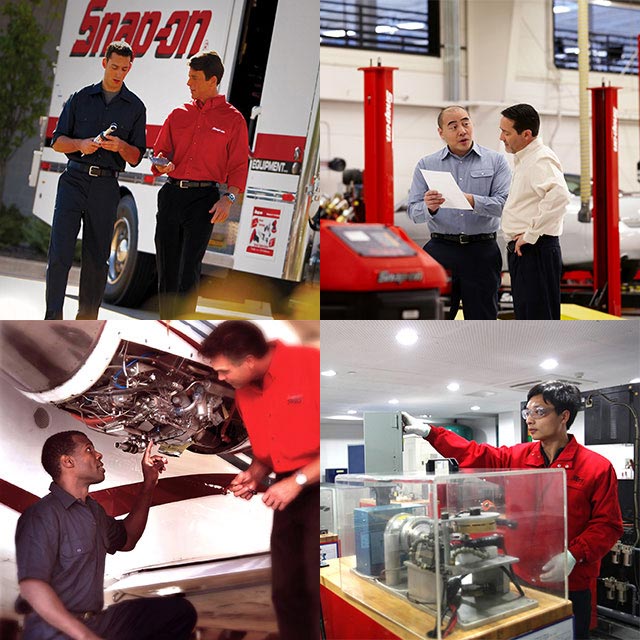
Snap-on is positioned for the future with favorable vehicle population trends, increasing vehicle complexity, growing demand in emerging markets and significant opportunities in industries outside of vehicle repair. To capitalize on these opportunities, we are investing strategically in these wide runways for growth in order to reach more professionals:
Enhance the Franchisee Network — Mobile Showrooms
In 2011, Snap-on began helping franchisees extend their reach through innovative selling processes, such as the Snap-on TechKnow Express vans for diagnostics and the Rock N’ Roll Cab Express vans for tool storage that break the traditional time and space barriers inherent in a franchisee van. In 2017, there were over 50 TechKnow Express and over 60 Rock N’ Roll Cab Express mobile showroom vans on the road that have expanded franchisees’ ability to more fully showcase the range of productivity solutions offered.
Expand with Repair Shops — Equipment & Big Data
In 2013, Challenger Lifts joined the Snap-on family; well known for break-through innovations such as the industry’s first 3-stage front and 3-stage rear arm 2-post lift, and the industry’s first realGREEN™ lifts that run on air and water. Pro-Cut International, which designs, manufactures and distributes on-car brake lathes was acquired in 2014. Ecotechnics, which designs and manufactures automatic vehicle air conditioning maintenance equipment for OEM dealerships and the automotive aftermarket worldwide, joined Snap-on in 2015. Given trends in the collision repair space, including the need for greater precision, the requirement to accommodate new materials and the higher emphasis on shop efficiency, the 2016 addition of Car-O-Liner brought greater capabilities in collision repair and strengthened our position in the heavy duty segment. All these additions to the Snap-on Repair Systems & Information Group complement existing product lines and expand Snap-on’s solutions for repair shop owners and managers.
Bahco Celebrates 125 Years
2011 marked the 125th anniversary of Bahco’s iconic Fish and Hook trademark. Our Bahco® brand continues to grow in importance, providing a powerful vehicle for expansion throughout the world, especially in the emerging markets of Eastern Europe and Asia-Pacific. Beginning with Swedish inventor J.P. Johansson’s first patent for ‘The Iron Hand’ (better known as the pipe wrench), strong capabilities in product innovation and design continue to be identified with Bahco today. Bahco products deliver unique ergonomics and other strong user benefits across a wide range of professional applications.
Extend to Critical Industries — Torque Solutions
The Snap-on Commercial & Industrial Group significantly expanded its precision and powered torque capabilities to better serve critical industries by complementing its existing solutions through the acquisitions of both Sturtevant Richmont in 2016 and Norbar Torque Tools in 2017. Sturtevant Richmont designs, manufactures and distributes mechanical and electronic torque wrenches as well as wireless torque error proofing systems for industrial applications. Norbar manufactures a full range of torque products, including wrenches, multipliers and calibrators and has a strong presence in critical industries, including power generation, oil & gas, mining and railroad.
Build in Emerging Markets — Physicals
The task: to build a physical presence in China and make products there for the local market. In 2010, there were 160 cities in China with over 1,000,000 people (there were nine in the U.S.) and this urbanization trend only continued. In 2010, the average age of vehicles in China was relatively young at four years-old, but the repair wave was coming with a rapidly growing and aging car base. There were products to be designed, factories to be launched, a sales network to be established and a Snap-on team to be built. Starting in the 2000s and continuing into the 2010s, land was purchased in Kunshan and multiple factories built to produce power tools, diagnostics, hacksaw and bandsaw blades, tool storage, lifts and undercar equipment. In 2011, a state-of-the-art design center was opened in Kunshan to develop products for the local market. In 2014, Snap-on significantly upgraded the factory line at its hand tool facility in Xiaoshan, purchased a few years earlier. By 2017, Snap-on had offices in 48 cities, five factories and an advanced design center all in China.
Today, Snap-on is a $3.7 billion, S&P 500 company headquartered in Kenosha, Wisconsin, offering products and services that are available around the world.
Now we define our value proposition more broadly, reaching beyond the garage.

Snap-on rewards people who make a positive difference.